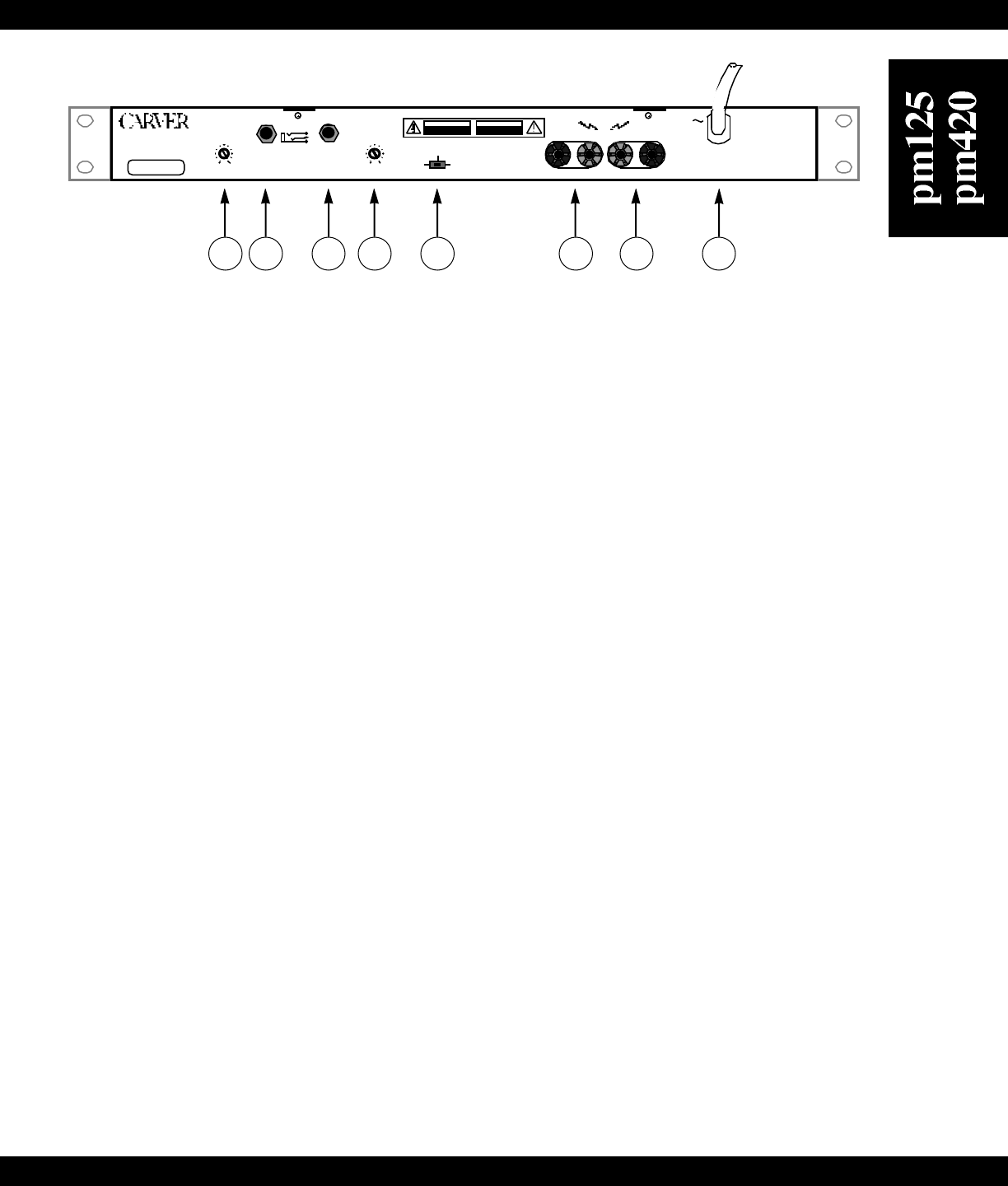
5. CH1/CH2 LEVEL CONTROLS
These controls are used to adjust the input level of each channel. When the controls are fully clockwise the
amplifier operates at maximum gain. Turning the controls counter-clockwise attenuates the input signal.
The LEVEL controls can be bypassed by moving the jumpers located at J15 and J16, next to the LEVEL
pots on the amplifier’s main circuit board. Plugging the jumper leads into sockets 1 and 2 will bypass the
LEVEL controls, locking the amplifier into full gain (as if the LEVEL pots were fully clockwise).
The depth of the LEVEL controls can be changed by physically removing the pots from the amplifier board
and moving them to a second set of holes in the board. In this way they can either protrude from the chassis
for easy adjustment, or be recessed to protect the controls from inadvertently being moved once they are set.
CAUTION: To avoid the risk of electric shock, refer all internal adjustments to qualified service personnel.
6. CH1/CH2 INPUT CONNECTORS
These are 1/4-inch TRS (Tip-Ring-Sleeve) phone jacks. They can be used with balanced signals or
unbalanced signals (see Input Wiring on page 9 for more information).
7. STEREO/MONO SWITCH
This switch is used to select between NORMAL STEREO operation, DUAL MONO operation or
BRIDGED MONO operation. For NORMAL STEREO operation, use CH1 and CH2 inputs. For DUAL
MONO or BRIDGED MONO operation, use CH2 input only (see page 10 and page 11 for more
information).
8. CH1/CH2 SPEAKER OUTPUTS
Multi-way binding posts are used to connect loudspeakers to the amplifier outputs. The red terminals are the
signal connection (+) and the black terminals are the signal return connection (–). The black terminals are
internally tied together and to signal ground.
9. POWER CORD
Connect to a properly configured outlet providing the line voltage specified for your model.
CAUTION ATTENTION
RISQUE DE CHOC ELECTRIQUE
NE PAS OUVRIR
RISK OF ELECTRIC SHOCK
DO NOT OPEN
TO REDUCE THE RISK
OF FIRE OR ELECTRIC
SHOCK, DO NOT EXPOSE
THIS EQUIPMENT TO RAIN
OR MOISTURE.
WARNING:
120 VAC
50-60 Hz
250 WATTS
CLASS II WIRING
MAY BE USED.
DUAL
MONO
NORMAL
(STEREO)
BRIDGED
MONO
OFF 0dB
OFF 0dB
MADE IN U.S.A.
INPUT IMPEDANCE 22K OHM EACH LEG
TO GROUND (TOTAL 44K OHMS BALANCED)
DRIVE CH 2 IN BRIDGED MONO
10 11
POWER
ON
2
A
M
P
HEADPHONES
CH 1 CH 2
CLIP/PROTECT CLIP/PROTECT
SIGNAL SIGNAL
READY READY
2
1
4
5
3 4 6 7 8 9
5
86
Controls And Functions
1. POWER SWITCH
When this switch is engaged, the power turns ON and the READY indicators illuminate. Be sure all
connections are made and double-checked before switching the power amplifier on.
2. CIRCUIT BREAKER
This protection device will trip if the line current exceeds the rating of the circuit breaker, causing the
amplifier to shut down completely. This operates the same as a standard line fuse, except that it is resettable
from the front panel after cooling down for a few seconds.
3. HEADPHONES (PM125 ONLY)
All conventional dynamic headphones may be plugged in here. Headphone impedance may range from a
few ohms to several thousand ohms, although output level will vary depending on the impedance.
The HEADPHONES output is tapped directly off of the Speaker Output terminals and is therefore affected
by the setting of the LEVEL controls on the rear panel.
Note: Do not use headphones when the amplifier is switched to Bridged Mono operation. The left channel
(CH1) will be out of phase with the right channel (CH2).
4. CH1/CH2 STATUS INDICATORS
These LEDs display information about the operation of the amplifier.
READY – These LEDs illuminate green when the power is on and the amplifier is ready to operate. The
READY LEDs illuminate red when the power switch is first turned on (while the power supply is stabilizing
prior to the speaker output relays switching in), or when the amplifier is in protect mode.
SIGNAL – These LEDs illuminate yellow when a signal is present at the Speaker Output jacks to provide an
indication of output power relative to full power (0dB).
CLIP/PROTECT – These LEDs illuminate red when the power switch is first turned on, when the output
begins to clip, or whenever there is a fault condition detected that causes the output relay(s) to disengage.
These fault conditions include excessive DC Offset, excessive heatsink temperature and short circuits at the
speaker output(s).
Note: The relays operate independently for each channel. Therefore, it is possible for one channel to operate
normally while the other is in “protect” mode.


















